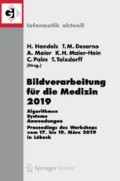Zusammenfassung
Further developments of the medical virtual reality application MedicVR were achieved by new approaches to direct volume rendering with the HTC Vive head mounted display. Even though the necessary real-time performance for a smooth interactive experience is accomplished by the shader technologies, the rendered image quality and performance is influenced by several parameters. We propose in this paper multiple technological upgrades to our application including: Lens Matched Shading, interactive volume clipping, semi-adaptive sampling, global illumination in direct volume rendering with shadow rays as well as an optimisation method for shadow rays and multiple light source integration. The quality of the rendered images is increased while keeping impact on performance at minimal levels. The application is currently used in study and planning in the field of dentofacial surgery.
Access this chapter
Tax calculation will be finalised at checkout
Purchases are for personal use only
Preview
Unable to display preview. Download preview PDF.
Literatur
Engel K, Hadwiger M, Kniss J, et al. Real-time volume graphics. CRC Press; 2006.
Hänel C, Weyers B, Hentschel B, et al.; IEEE. Interactive volume rendering for immersive virtual environments. IEEE VIS Int Workshop 3DVis. 2014; p. 73-74.
Mastmeyer A, Fortmeier D, Handels H. Direct haptic volume rendering in lumbar puncture simulation. Med Meet Virtual Real 19: NextMed. 2012;173:280-286.
Fortmeier D, Mastmeyer A, Schröder J, et al. A virtual reality system for PTCD simulation using direct visuo-haptic rendering of partially segmented image data. IEEE J Biomed Health Inform. 2016;20(1):355-366.
Scholl I, Suder S, Schiffer S. Direct volume rendering in virtual reality. Procs BVM. 2018; p. 297-302.
Edward L. Lens matched shading and unreal engine 4 integration Ppart 1; 2018. [Accessed 26-10-2018]. [Online]. Available from: https://developer.nvidia.com/lensmatched-shading-and-unreal-engine-4-integration-part-1.
Levoy M. Display of surfaces from volume data. IEEE Comput Graph Appl. 1988;(3):29-30.
Ropinski T, Kasten J, Hinrichs. Efficient shadows for GPU-based volume raycasting. WSCG Full Pap. 2008; p. 17-24.
Author information
Authors and Affiliations
Corresponding author
Editor information
Editors and Affiliations
Rights and permissions
Copyright information
© 2019 Springer Fachmedien Wiesbaden GmbH, ein Teil von Springer Nature
About this paper
Cite this paper
Scholl, I., Bartella, A., Moluluo, C., Ertural, B., Laing, F., Suder, S. (2019). MedicVR. In: Handels, H., Deserno, T., Maier, A., Maier-Hein, K., Palm, C., Tolxdorff, T. (eds) Bildverarbeitung für die Medizin 2019. Informatik aktuell. Springer Vieweg, Wiesbaden. https://doi.org/10.1007/978-3-658-25326-4_32
Download citation
DOI: https://doi.org/10.1007/978-3-658-25326-4_32
Published:
Publisher Name: Springer Vieweg, Wiesbaden
Print ISBN: 978-3-658-25325-7
Online ISBN: 978-3-658-25326-4
eBook Packages: Computer Science and Engineering (German Language)

